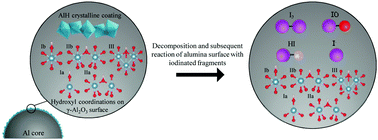Adsorption and exchange reactions of iodine molecules at the alumina surface: modelling alumina-iodine reaction mechanisms†
Abstract
Harnessing aluminum oxidation energy requires navigating the particle's passivation shell composed of alumina. The shell is a barrier to aluminum oxidation but can also exothermically react with halogenated species and therefore contribute to the overall energy generated during aluminum particle combustion. Fluorination reactions with alumina have been studied because fluorine is abundant in binder formulations that commonly surround aluminum particles in an energetic mixture. However, iodine has emerged as an alternative halogenated-based binder or oxidizer because iodine gas provides ancillary benefits such as chemical neutralization of biological agents or sterilization of contaminated environments. This study used density functional theory (DFT) calculations to evaluate potential reaction pathways for aluminum–iodine combustion. Relative to fluorinated fragments such as HF and F−, the adsorption energies associated with HI and I− are nearly triple the exchange reaction energy available from fluorination reactions with alumina (−189 and −278 kJ mol−1 for HI and I−, respectively). However, exchange reactions between iodinated species and the alumina surface are energetically unfavorable. These results explain that through adsorption, alumina surface exothermic reactions with iodine are more energetic than with fluorine fragments. Experiments performed with differential scanning calorimetry (DSC) confirm the higher magnitude of energy generated for iodination compared with fluorination reactions with alumina. Additionally, strong adsorption energies can promote synthesis of new shell chemistries. Adsorption in solution will promote alumina dissolution and iodine precipitation reactions to produce hydroxyl complexes and iodinated species synthesized on the surface of the particle, thereby replacing alumina with alternative passivation shell chemistry.

- This article is part of the themed collection: 2022 PCCP HOT Articles


 Please wait while we load your content...
Please wait while we load your content...
